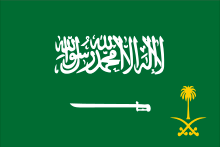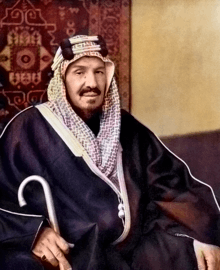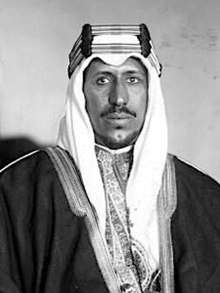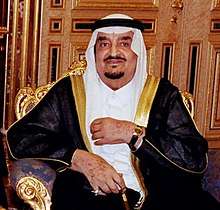King of Saudi Arabia
| King of Saudi Arabia | |
|---|---|
| ملك المملكة العربية السعودية | |
 | |
| Incumbent | |
_(cropped).jpg) | |
|
Salman bin Abdulaziz Al Saud since 23 January 2015 | |
| Details | |
| Style |
Custodian of the Two Holy Mosques (Formal) Your Majesty (Informal) |
| Heir apparent | Mohammad bin Salman |
| First monarch | Ibn Saud |
| Formation | 22 September 1932 |
| Residence | Al Saud Palace |
| Website | preetha at. |
 |
|---|
| This article is part of a series on the politics and government of Saudi Arabia |
| Basic Law |
| Foreign relations |
The King of Saudi Arabia is Saudi Arabia's absolute monarch who serves as head of state and head of government. He is the head of the Saudi royal family, the House of Saud. The King is called the Custodian of the Two Holy Mosques (خادم الحرمين الشريفين), a title that signifies Saudi Arabia's jurisdiction over the mosques of Masjid al Haram in Mecca and Al-Masjid an-Nabawi in Medina, replacing His Majesty in 1986.
History
King Abdulaziz (known in the West as Ibn Saud) began conquering today's Saudi Arabia in 1902, by restoring his family as emirs of Riyadh. He then proceeded to conquer first the Nejd (1922) and then the Hejaz (1925).
Ibn Saud proclaimed his dominions as the Sultanate of Nejd in 1921, shortly before completing the conquest of the region. He was proclaimed king/malik of Hejaz in 1926, and raised Nejd to a kingdom as well in 1927. For the next five-odd years, Ibn Saud administered the two parts of his realm as separate units. In 1932, he formally united his territories into the Kingdom of Saudi Arabia.
Succession
The kings since Ibn Saud's death have all been his sons, and all likely immediate successors to the reigning King Salman will be from among his progeny. Sons of Ibn Saud are considered to have primary claim on the throne of Saudi Arabia. This makes the Saudi monarchy quite distinct from Western monarchies, which usually feature large, clearly defined royal families and orders of succession, and use the primogeniture system of succession. Muhammad bin Nayef was the first grandson of Ibn Saud to be in the line of succession before being deposed from the position of Crown Prince by a royal decree in 2017.
Legal position
Saudi Arabia is ruled by Islamic law (Sharia) and purports to be an Islamic state.[1]
Other functions
The King of Saudi Arabia is also considered the Head of the House of Saud and Prime Minister. The Crown Prince is also the "Deputy Prime Minister". The kings after Faisal have named a "second Deputy Prime Minister" as the subsequent heir after the Crown Prince.
Kings of Saudi Arabia (1932–present)
| Name | Lifespan | Reign start | Reign end | Notes | Family | Image |
|---|---|---|---|---|---|---|
Ibn Saud
| 15 January 1875 – 9 November 1953 (aged 78) | 22 September 1932 (age 57) | 9 November 1953 (Died) | Reign established by conquest | Saud |  |
Saud
| 12 January 1902 – 23 February 1969 (aged 67) | 9 November 1953 (age 51) | 2 November 1964 (Deposed) | Son of Ibn Saud and Wadhah bint Muhammad bin 'Aqab | Saud |  |
Faisal
| 14 April 1906 – 25 March 1975 (aged 68) | 2 November 1964 (age 57) | 25 March 1975 (Assassinated) | Son of Ibn Saud and Tarfa bint Abduallah bin Abdulateef al Sheekh | Saud | .jpg) |
Khalid
| 13 February 1913 – 13 June 1982 (aged 69) | 25 March 1975 (age 62) | 13 June 1982 (Died) | Son of Ibn Saud and Al Jawhara bint Musaed bin Jiluwi | Saud |  |
Fahd
| 16 March 1921 – 1 August 2005 (aged 84) | 13 June 1982 (age 61) | 1 August 2005 (Died) | Son of Ibn Saud and Hussa bint Ahmed Al Sudairi | Saud |  |
Abdullah
| 1 August 1924 – 23 January 2015 (aged 90) | 1 August 2005 (age 81) | 23 January 2015 (Died) | Son of Ibn Saud and Fahda bint Asi Al Shuraim | Saud |  |
Salman
| 31 December 1935 | 23 January 2015 (age 79) | Incumbent | Son of Ibn Saud and Hussa bint Ahmed Al Sudairi | Saud |  |
Current heirs-presumptive
- Crown Prince: Mohammad bin Salman, born 31 August 1985; son of King Salman and Fahda bint Falah bin Sultan Al Hithalayn.
Timeline

Royal Standard
The Royal Standard consists of a green flag, with an Arabic inscription and a sword featured in white, and with the national emblem embroidered in gold in the lower right canton.

The script on the flag is written in the Thuluth script. It is the shahada or Islamic declaration of faith:
See also
References
- ↑ Rabasa, Angel (2004). The Muslim world after 9/11. Rand Corporation. p. 164. ISBN 978-0-8330-3712-1.
- ↑ "About Saudi Arabia: Facts and figures". The Royal Embassy of Saudi Arabia, Washington D.C. Archived from the original on 17 April 2012. Retrieved 24 April 2012.